Pepper Pests, Diseases and Problems
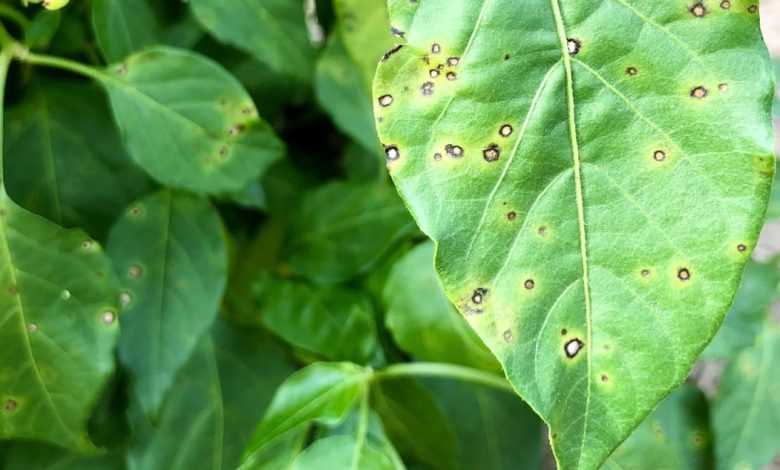
**In this article we analyze the most common (and serious) diseases, pests and problems that your pepper plants can suffer. We try to describe the symptoms as well as their possible solutions as precisely as possible.
Peppers, Capsicum annuum, are a group of annual or perennial plants in the Solanaceae family that are grown for their edible fruits, the peppers.
Pepper plants are short bushes with woody stems that produce brightly colored fruit.
The alternate leaves are elliptical, smooth-edged, and come to a distinct tip.
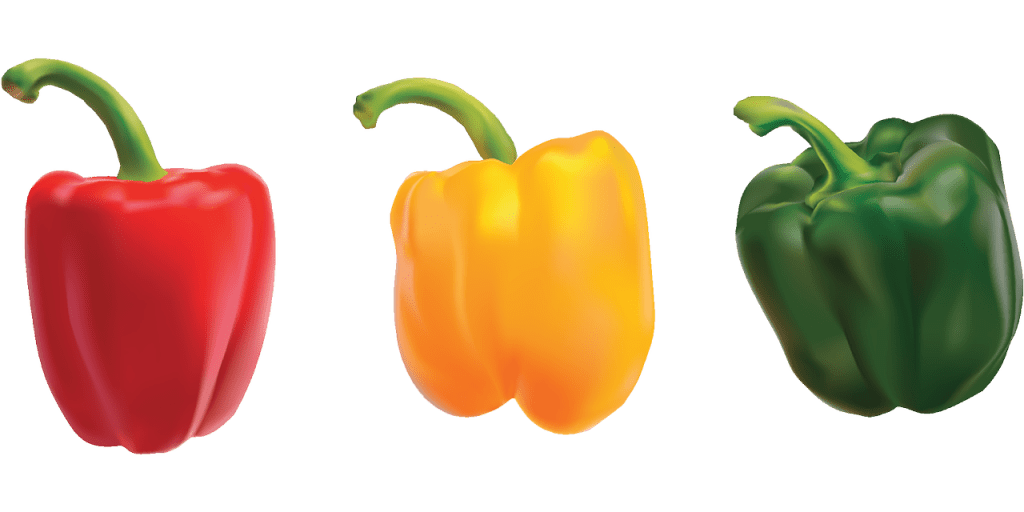
The plant produces white or purple bell-shaped flowers 2.5 cm in diameter. Red, yellow, purple or brown fruits are produced each season about 3-6 weeks after flowering.
Pepper plants can grow 1 m tall and are normally grown as an annual in temperate regions for a single growing season.
The bell pepper may be referred to as a red, yellow, or green bell pepper and is believed to be native to Central and South America.
Points to keep in mind to keep many pepper pests and diseases at bay
- Buy certified seeds: whenever possible when growing your own peppers, buy certified seeds or seedlings. You will avoid many problems.
- Avoid excess moisture in the soil: Irrigation that floods the soil can lead to a greater number of fungal and bacterial diseases.
- Avoid watering the leaves: If we water the leaves, the humidity is deposited and both fungi and insects proliferate.
- Whenever you can, use ecological options: use more ecological options such as neem extract or potassium soap.
- Monitor the pH of the soil: the pH levels will indicate how our peppers are going to evolve.
- Watch for nutrient deficiencies, such as nitrogen or magnesium.
Pepper fungal diseases
Anthracnose, Colletotrichum spp.
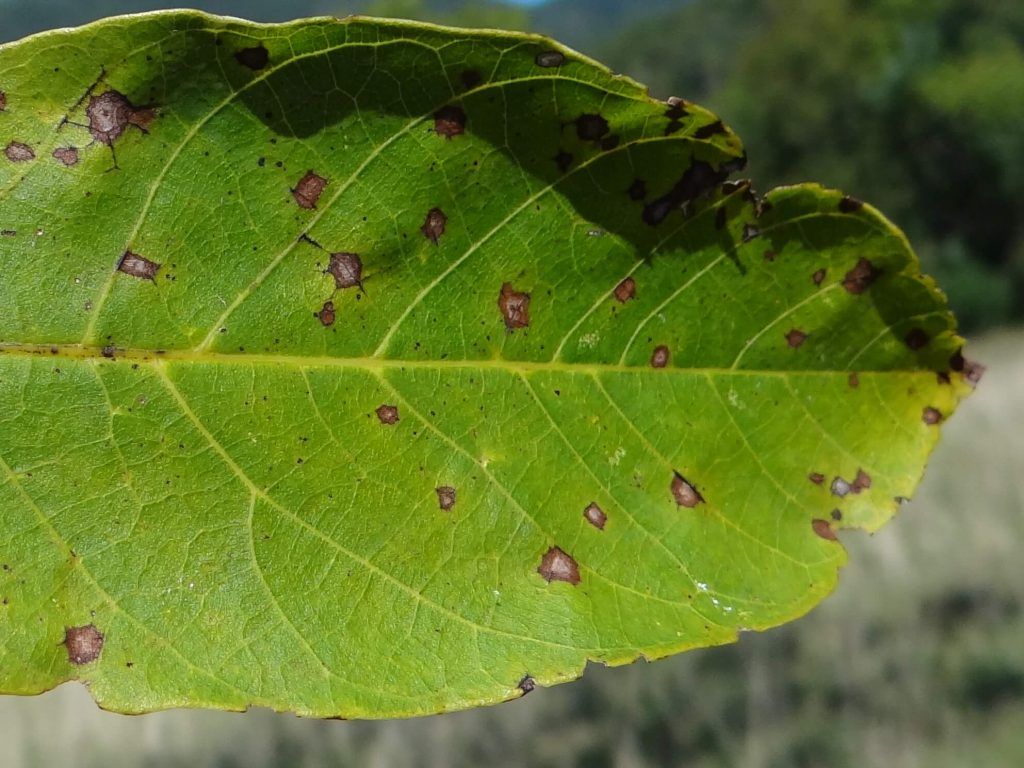
Symptoms: Circular lesions on fruit containing concentric rings of tan to orange and black in the center.
The lesions usually reach 3 cm in diameter, but can expand to cover most of the fruit surface.
Lesions can also occur on leaves and stems and appear as irregularly shaped gray spots with dark margins.
Cause: Fungi. Anthracnose is found in major vegetable growing areas around the world and can cause heavy losses if left untreated.
Control and management: Always plant seeds and transplants free of the disease. Seeds can be freed from infection by treating them with hot water at 52°C for 30 minutes.
If we know that the disease is present, the field should be rotated with non-susceptible crops for a period of 3 years.
Plowing crop residues deep into the soil and removing crop debris can help reduce inoculum in the soil.
- To learn more: Identify and combat anthracnose.
Cercospora leaf spot (Frogeye leaf spot), Cercospora capsici
Symptoms: The initial symptoms of infection are the formation of small circular water-soaked spots on the leaves, stems, petioles and/or peduncles.
The lesions mature and have white to brown centers surrounded by a brown to red or purple border; as lesions expand, they may develop a water-soaked outer rim and a dark outer ring that gives the lesions a concentric appearance.
Mature lesions are brittle and crack in the center; lesions can be between 0.3 and 1.3 cm in diameter.
Cause: Fungus. Cercospora leaf spot is a disease mainly of tropical and subtropical countries and occurs mainly in Africa, South America, Asia and the Antilles.
Control and management: Cercospora infections are usually minor in peppers and do not require treatment.
Crop debris must be removed and destroyed after harvest or buried in the ground; application of a suitable fungicide can help reduce damage if applied early in the infection.
The practice of crop rotation reduces the incidence of the disease.
Wetting, Pythium spp.
Symptoms: The seeds do not germinate. Seedlings collapse and die; dark stems that crinkle near the soil line.
Stem lesions with high humidity; discolored roots soaked in water.
Cause: Fungi. The disease can spread in infected soil and in irrigation water. The appearance of the disease is favored by the crowding of the plants and the excessive fertilization with nitrogen.
Management and control: Avoid planting in moist, fresh and poorly drained soils; planting in raised beds will help drain the soil.
Plant high-quality seeds that germinate quickly. Treat seeds with fungicides before planting to kill pathogenic fungi.
Fusarium wilt, Fusarium oxysporum

Symptoms: Yellowing of foliage and wilting of upper leaves.
Wilting spreads to all parts of the plant; the leaves remain attached to the plant and are dark green. Red-brown discoloration of vascular tissue. Plant death.
Cause: Fungus. The appearance of the disease favors a high moisture content in the soil.
Management and control: Plant the pepper in well-drained soils and avoid waterlogging.
Gray leaf spot, Stemphylium spp.
Symptoms: The initial symptoms of the disease appear as small reddish-brown spots on the leaves measuring 1-2 mm in diameter.
As the disease progresses, the lesions expand and become lighter in the center.
Lesions expand to 3-5 mm in diameter, and mature lesions have white or gray centers and reddish-brown margins.
A large number of lesions can form on the leaves, causing them to turn yellow and fall off the plant.
Cause: Fungi. The disease has a worldwide distribution, but is most common on peppers grown in the cool season in tropical and subtropical climates; the pathogen also attacks tomatoes.
Management and control: As pepper nursery beds appear to be more susceptible to gray leaf spot infection, control relies on good bed management.
The beds must be well ventilated and all crop debris must be removed quickly.
The beds should not be planted next to fields of peppers or tomatoes.
If the disease is present and widespread, the application of appropriate fumigant fungicides should be effective in eradicating the pathogen.
Powdery mildew, Leveillula taurica
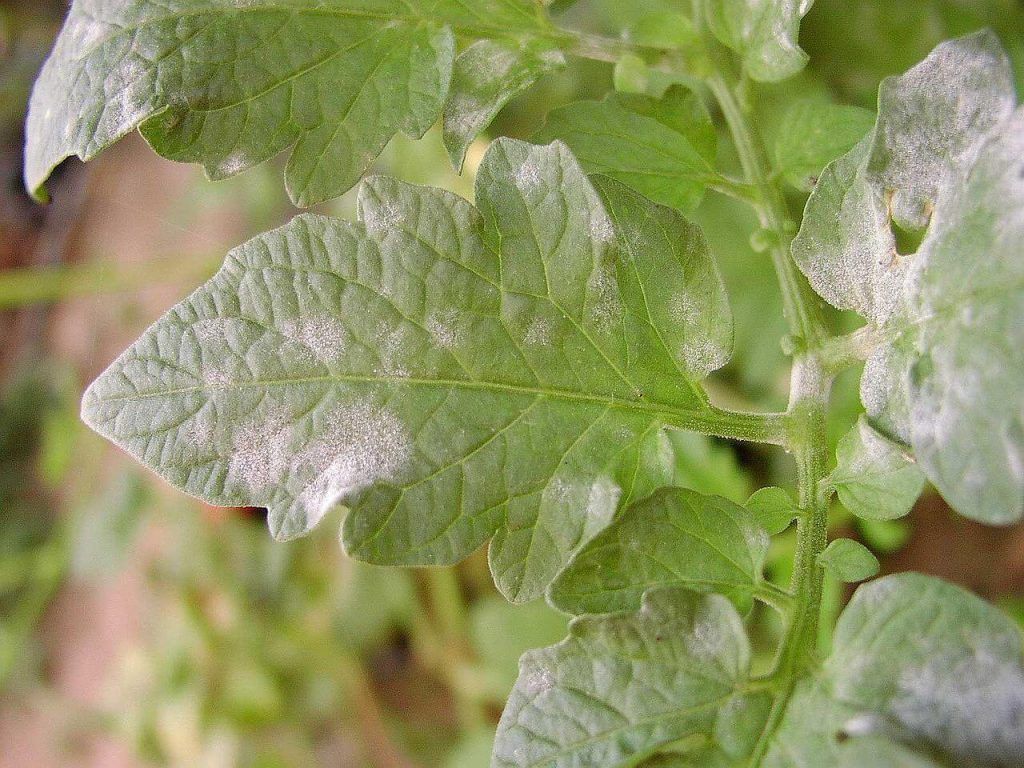
Symptoms: Spots of white, powdery fungal growth on the undersides of leaves.
Yellow to brown discoloration of the upper leaf surface. Leaf edges may curl upward exposing the underside of the leaf; leaves may begin to fall off the plant.
Cause: Fungus. The disease can appear in both wet and dry conditions; disease spreads more rapidly in moist conditions; the disease usually affects older leaves.
Management and control: Apply suitable fungicide if the disease is severe.
Southern blight, Sclerotium rolfsii
Symptoms: Sudden wilting of the leaves. Yellowish foliage. Stem brownish above and below ground. brownish branches.
The stem may be covered with a fan-shaped mycelial mat.
Cause: Fungus. The fungus can survive in the soil for long periods.
The appearance of the disease is favored by high temperatures, high humidity and acid soil; the disease is found mainly in tropical and subtropical regions.
Control and management: Remove infected plants.
Avoid crowding plants to promote air circulation.
Rotate crops with less susceptible plants. Plow the remains of the crop deep into the ground; Provide a barrier to infection by wrapping the lower stems of the plant with aluminum foil covering the bottom of the stem and 2-3 at the soil line.
Verticillium wilt, Verticillium spp.
Symptoms: Initial symptoms of the disease include stunting of plants and yellowing of lower leaves.
As the infection progresses, more leaves turn yellow and begin to drop from the plant.
Plants wilt during the day and recover at night; wilting becomes permanent and plant death occurs.
Cause: Fungi. The disease is present on peppers grown in Europe, Canada, and the United States.
The severity of the disease when it appears depends on many factors, such as the strain of the pathogen, the susceptibility of the host, the type of soil and the prevailing climatic conditions.
Control and Management: There are currently no effective control strategies for Verticillium wilt once it is present in the field.
Cultural control practices should be employed to reduce the chances of the disease appearing in the first place.
Management strategies include crop rotation every 3-4 years away from pepper. Soil fumigation and/or solarization can reduce the level of inoculant in the soil.
Bacterial diseases of peppers
Bacterial canker Clavibacter michiganensis
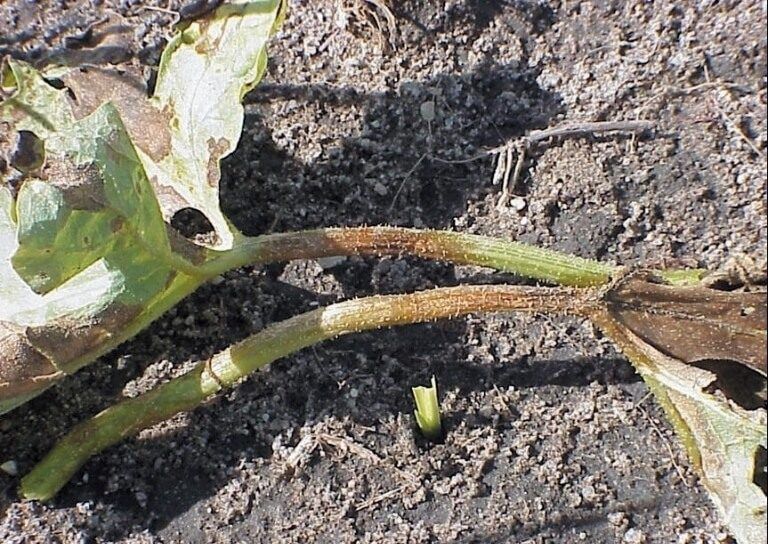
Symptoms: Small white raised lesions on growing leaves, turn brown and necrotic and may have a yellow halo.
Raised white lesions on fruit that coalesce to form larger spots, often with a white halo.
Cause: Bacteria. The symptoms can be confused with those of a bacterial spot.
The appearance of the disease favors high temperatures and high humidity; the disease can spread between peppers and tomatoes
Control and management: Use only certified seeds and transplants free of the disease.
Treat the seeds with hot water before planting to kill bacteria. Disinfect all equipment regularly; Rotate crops with non-Solanaceous plants.
- To learn more: Detect and combat bacterial canker.
Bacterial spot, Xanthomonas campestris
Symptoms: Moisture lesions that dry out and turn brown on the undersides of leaves. Raised brown cankers on stems; cracked brown lesions on fruit.
Cause: Bacteria. The appearance of the disease is favored by warm and humid conditions.
The pathogen can enter the field through seeds and transplants and can be spread within the field by wind-driven rain, plant clippings, and aerosols.
Control and management: Use disease-free planting material. Remove and destroy all crop debris after harvest, or plow material deep underground.
Virus diseases of peppers
Mosaic, Cucumber mosaic virus
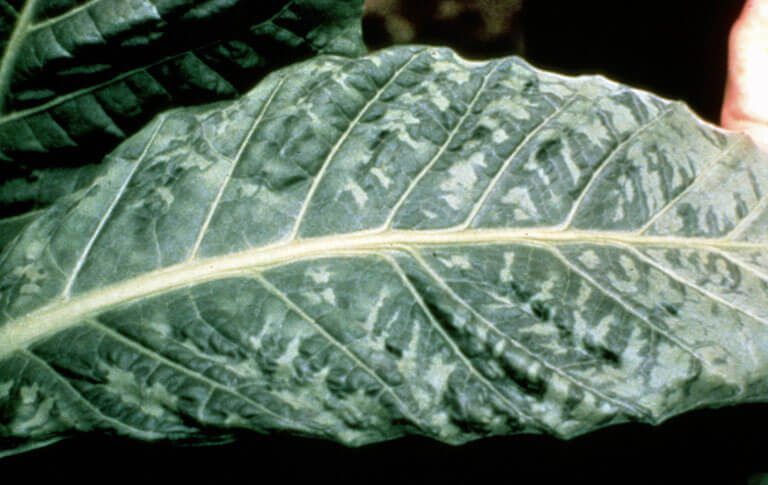
Symptoms: Light green areas or mosaic patterns are seen on the leaves. Distorted and curled leaves; slow plant growth.
Cause: Viruses. Transmitted by aphids. Weeds can act as a source of inoculum.
Insecticides are not effective due to the speed with which aphids can transmit the virus.
Control and management: Eliminate weeds around the crop. Use reflective mulches to deter aphids from plants. [/your_note]
- To know more: What is the mosaic virus and how can we fight it?
Tomato wilt virus
Symptoms: Symptoms can vary greatly depending on the variety and environmental conditions.
In general, the leaves become blotchy and take on a bronzed appearance; the plant may drop or wilt. The fruits develop light-colored concentric rings and become necrotic.
Cause: Viruses. The virus can infect a wide range of plants, including crops, ornamentals, and weeds.
Once acquired through thrips, which act as vectors of the disease, the insect is capable of transmitting the virus for the rest of its life.
Control and management: Disease management focuses on control of the thrips vector (see Thrips).
Pests that affect peppers
Aphids, Myzus persicae
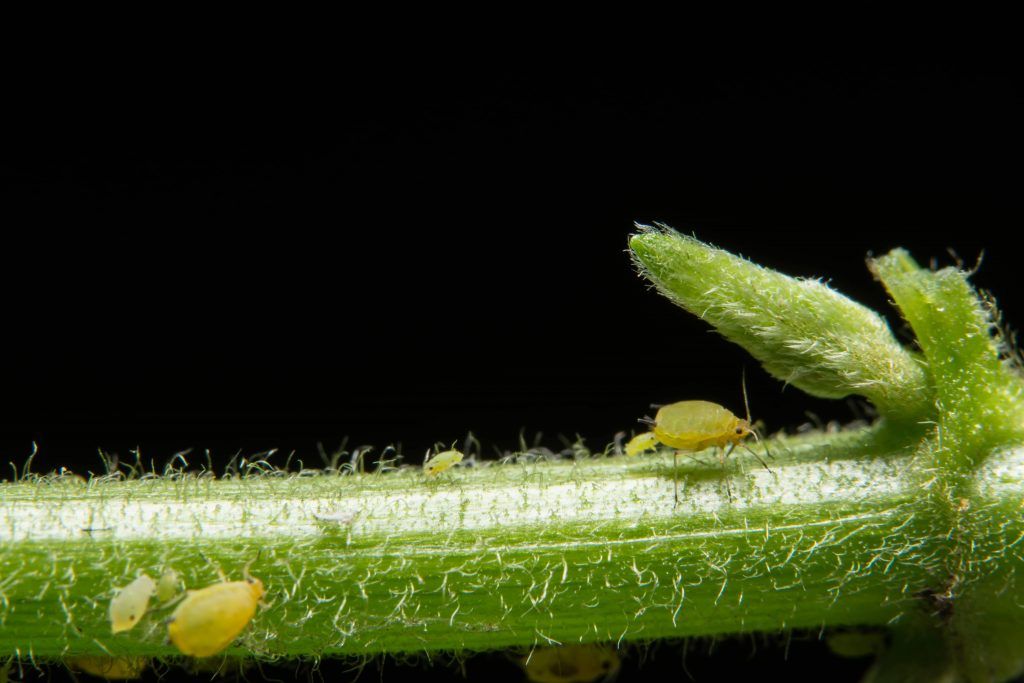
Symptoms: Small, soft-bodied insects on the undersides of leaves and/or plant stems. They are usually green or yellow in color, but can be pink, brown, red, or black, depending on the species and host plant.
If the aphid infestation is heavy, it can cause leaves to turn yellow and/or become deformed, necrotic spots to appear on leaves and/or shoot stunting.
Aphids secrete a sticky, sugary substance called honeydew that encourages sooty mold growth on plants.
Cause: Insect. Distinctive features include the presence of cornicles (tubular structures) projecting backwards from the aphid’s body; they usually do not move very quickly despite being disturbed.
Control and Management: If the aphid population is limited to a few leaves or shoots, the infestation can be pruned to control it.
Check transplants for aphids before planting. Use tolerant varieties if available.
Reflective mulches, such as silver-colored plastic, can deter aphids from feeding on plants. Robust plants can be sprayed with a strong stream of water to remove aphids from the leaves.
Insecticides are usually only necessary to treat aphids if the infestation is very heavy Plants generally tolerate low to medium level infestation; insecticidal soaps or oils, such as neem or canola oil, are often the best method of control.
Always check product labels for specific usage guidelines before using.
- To learn more: How to detect and combat aphids.
Beet bollworm, Spodoptera exigua
Symptoms: Singular or closely grouped circular or irregular holes in foliage. Intensive feeding by young larvae leads to skeletonization of leaves.
Superficial and dry wounds on the fruit. There may be egg clusters of 50 to 150 eggs on the leaves. The egg clusters are covered in a whitish scale that gives the cluster a cottony or fuzzy appearance.
Young larvae are pale green to yellow, while older larvae are generally darker green, with a dark and light stripe running down the side of their body and a pink or yellow underside.
Cause: Insect. The insect can go through 3-5 generations a year.
Control and management: Organic methods of control of the beet rootworm include biological control through natural enemies that parasitize the larvae and the application of Bacillus thuringiensis.
Chemicals are available for commercial control, but many of those available for the home garden do not provide adequate larval control.
Potato beetle, Leptinotarsa decemlineata
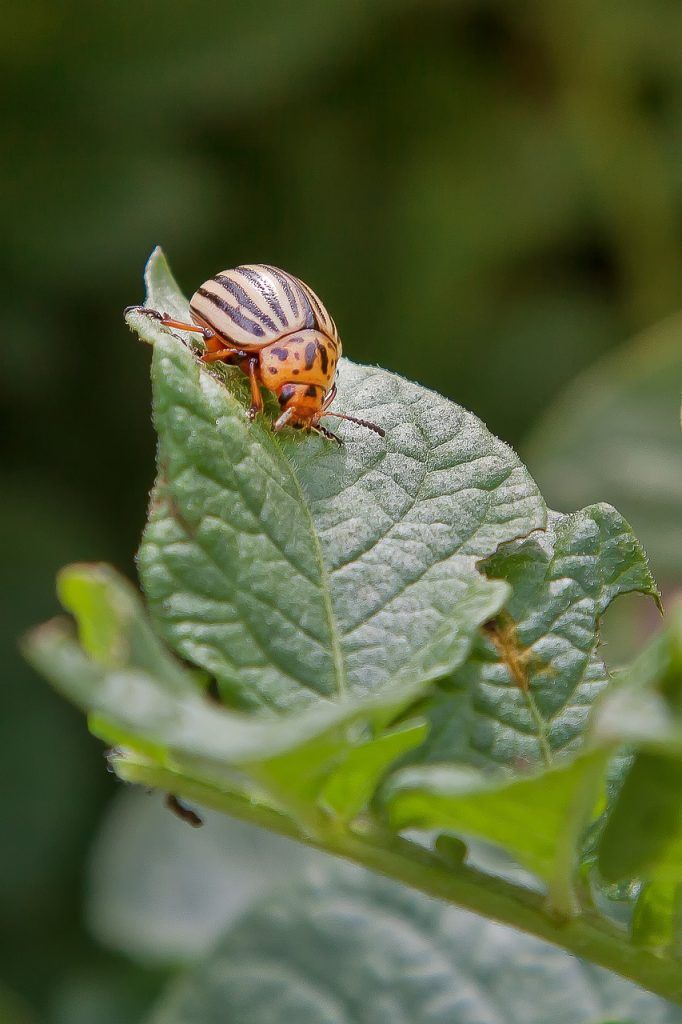
Symptoms: this plague affects the peppers causing damage to the leaves.
If the infestation is severe or left untreated, the plants can become completely defoliated.
The adult insect is a beetle with black and yellow stripes. Larvae are bright red with black heads when they first hatch and change color to pink; the larvae have two rows of black spots.
Cause: Insect. Adult beetles emerge in spring; females lay eggs in batches of up to two dozen.
The eggs are orange-yellow in color and are laid on the underside of the leaves; a female can lay 500 or more eggs in a period of four to five weeks.
Control and Management: Control of the potato beetle can be difficult as it has developed a high level of resistance to insecticides.
In the home garden, planting early maturing potato varieties allows plants to escape most damage.
Adults and larvae should be hand-picked from plants and destroyed in soapy water.
Bacillus thuringiensis applications can be effective in controlling larvae, but must be applied frequently. Some insecticides, including spinosad, are still effective against adult beetles.
flea beetles
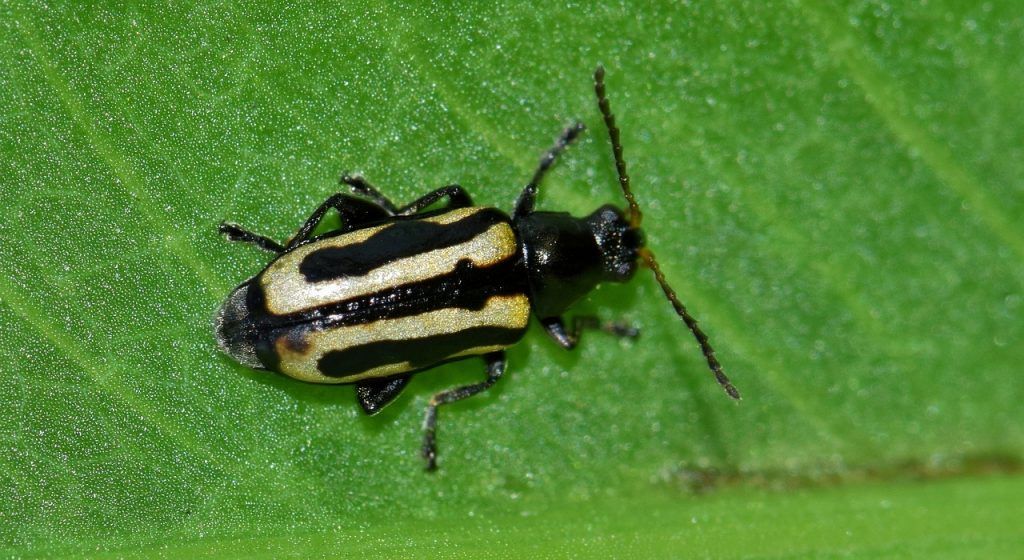
Symptoms: Peppers are affected with small holes or holes in the leaves leading to the foliage.
Young plants and seedlings are especially susceptible. Plant growth may be reduced. If the damage is severe, the plant may die.
The pest responsible for the damage is a small (1.5-3.0 mm) dark colored beetle that jumps when disturbed; the beetles usually have a shiny, metallic appearance.
Cause: Insects: Flea beetles may overwinter on nearby weed species, plant debris, or soil; insects can go through a second or third generation in a year.
Control and Management: In areas where flea beetles are a problem, it may be necessary to use floating row covers prior to beetle emergence to provide a physical barrier to protect young plants.
Plant seeds early to allow establishment before beetles become a problem – mature plants are less susceptible to damage.
Trap crops can provide a measure of control – cruciferous plants are best; applying a thick layer of mulch can help prevent beetles from reaching the surface.
The application of diamotecoeus earth or oils such as neem oil are effective control methods if you have an organic garden.
Application of insecticides containing carbaryl, spinosad, bifenthrin, and permethrin may provide adequate beetle control for up to a week, but will require reapplication.
Leaf miners, Lyriomyza spp.
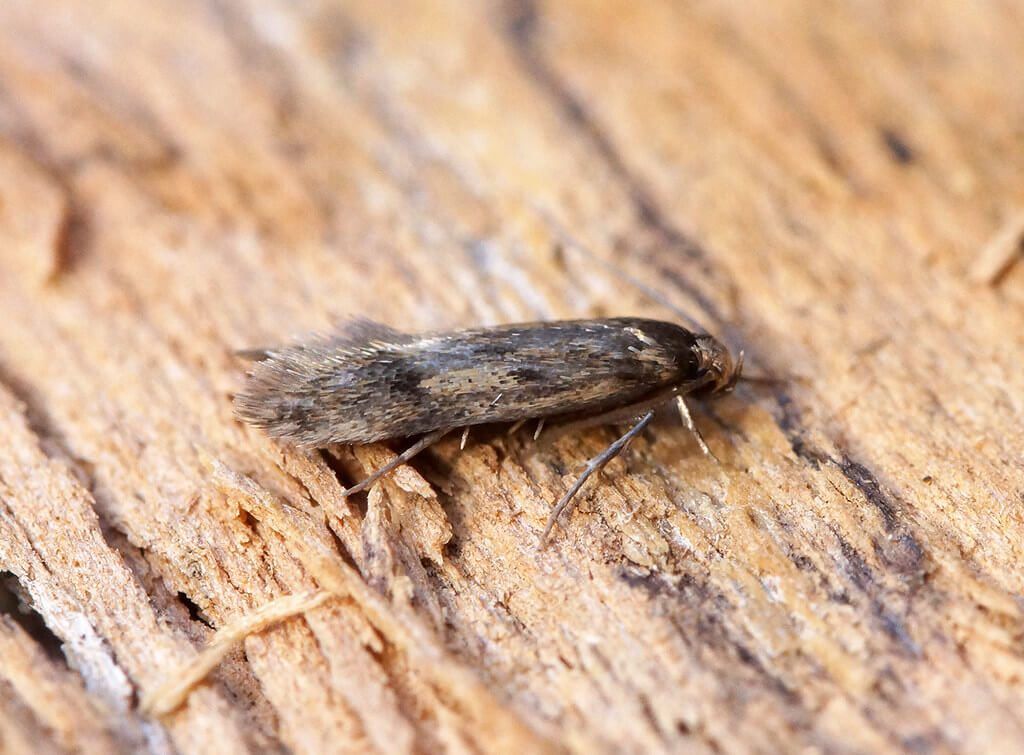
Symptoms: Fine, white, winding tracks on the leaves.
Heavy exploitation can lead to white spots on the leaves as they fall off the plant prematurely. Early infestation can reduce fruit yield.
The adult leafminer is a small black and yellow fly that lays its eggs on the leaf. The larvae hatch and feed on the inside of the leaf.
Advertisements
Cause: Insects. Mature larvae drop from leaves to the ground to pupate; complete life cycle may take as little as 2 weeks in warm climates; the insect can go from 7 to 10 generations a year.
Control and Management: Check transplants for signs of leafminer damage before planting.
Remove plants from the ground immediately after harvest.
Use insecticides only when leafminer damage has been detected, as unnecessary spraying will also reduce populations of their natural enemies.
Pepper weevil or weevil, Anthonomus eugenii
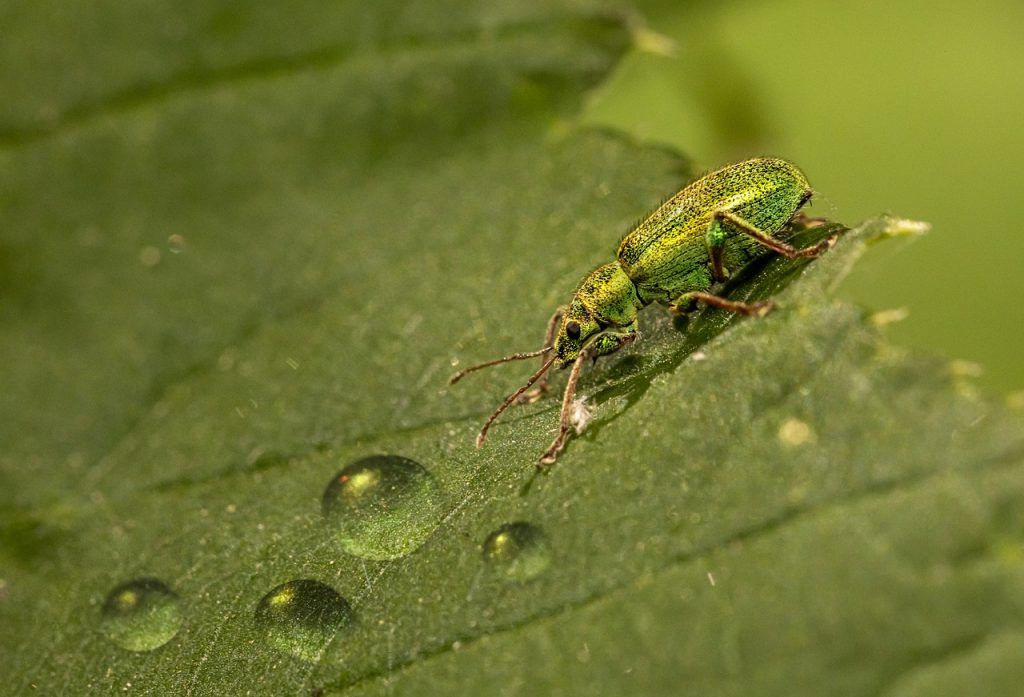
Symptoms: Damage to the surface of pepper leaves, especially to the shoots and tender pods of young fruit.
The larvae feed inside the shoots and fruits; older fruits become deformed and discolored. Buds and fruit can fall off the plant. The adult weevil is a small black beetle.
The larvae are small creamy-white worms with brown heads that can reach 0.6 cm (0.25 in) in length when mature.
Cause: Insect. The weevil goes through several generations a year. The pepper is its preferred host, but the weevil also feeds on other nightshades.
Control and management: Remove any nightshade plants that grow near the pepper.
Immediately remove any fallen fruit from the soil surface; if pepper weevil becomes a problem, rotate the crop the following year.
Acceptable organic control methods include pyrethrin spraying; destroy pepper crop residue immediately after harvest.
Advertisements
thrips
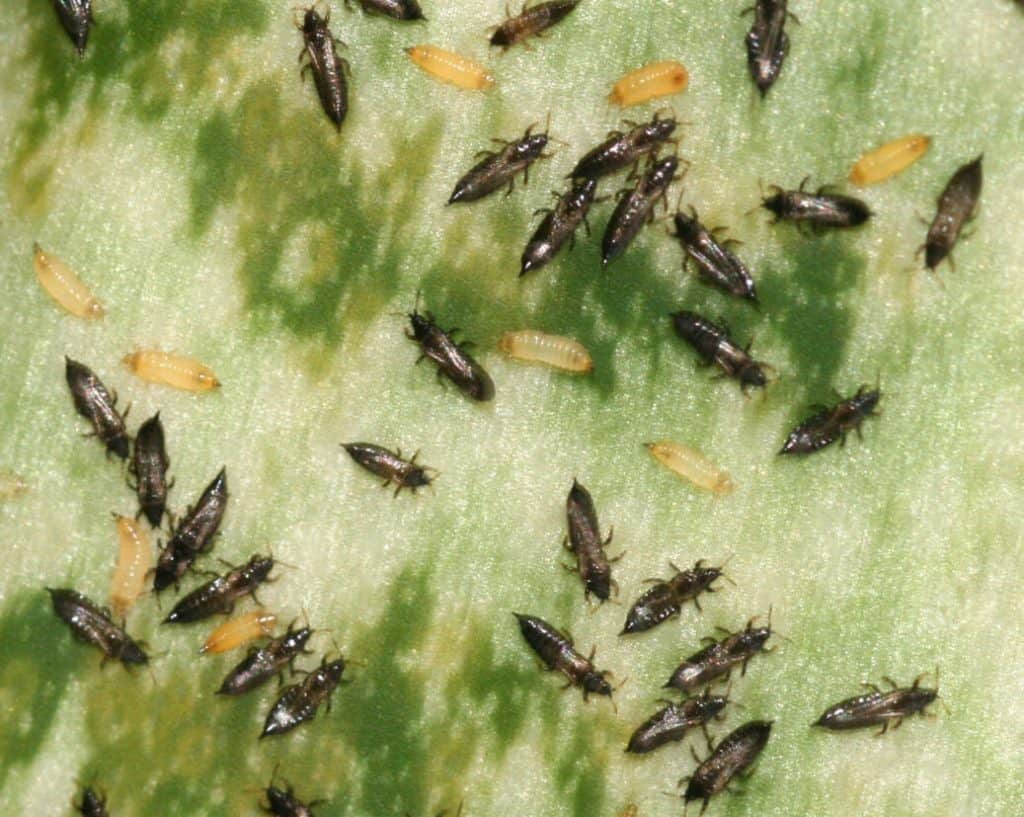
Symptoms: If population is high, leaves and shoots may be distorted.
Las hojas parecen plateadas y están moteadas con heces negras. Los insectos se alimentan de las flores y las dañan; la mayoría de los daños se producen por la transmisión del virus de la marchitez del tomate.
El insecto es pequeño (1,5 mm) y delgado y se ve mejor con una lente de mano. Los trips adultos son de color amarillo pálido a marrón claro y las ninfas son más pequeñas y de color más claro.
Causa: Insecto. El insecto transmite el virus de la marchitez del tomate (véase la entrada sobre la enfermedad); una vez adquirido, el insecto conserva la capacidad de transmitir el virus durante el resto de su vida.
Control y manejo: Evitar plantar junto a cebollas, ajos o cereales, donde pueden acumularse grandes cantidades de trips.
Utilizar mantillos reflectantes al principio de la temporada de cultivo para disuadir a los trips. Aplicar el insecticida adecuado si los trips se vuelven problemáticos.
- Para saber más: Detectar y combatir los trips en el huerto.
Ácaros (araña roja), Tetranychus urticae

Síntomas: Hojas salpicadas de amarillo; las hojas pueden parecer bronceadas.
Telarañas que cubren las hojas; los ácaros pueden ser visibles como pequeños puntos en movimiento en las telarañas o en el envés de las hojas, que se ven mejor usando una lente de mano. Normalmente no se detectan hasta que hay síntomas visibles en la planta.
Las hojas se vuelven amarillas y pueden caerse de la planta.
Cause: Arachnid. Mites thrive in dusty conditions; plants with water stress are more likely to be attacked.
Control and Management: In the home garden, spraying plants with a strong stream of water can help reduce the buildup of spider mite populations.
If the mites become troublesome, apply insecticidal soap to the plants. Certain chemical insecticides can increase mite populations by killing their natural enemies and promoting their reproduction.
- To know more: Detect and combat the red spider in the orchard.

![Photo of Phalloid Amanita: [Characteristics, Effects, Prevention and Reproduction]](https://www.complete-gardening.com/wp-content/uploads/2022/08/phalloid-amanita-characteristics-effects-prevention-and-reproduction-390x220.png)
![Photo of How to Plant a Cactus: Step by Step Manual [12 Steps + Images]](https://www.complete-gardening.com/wp-content/uploads/2022/08/how-to-plant-a-cactus-step-by-step-manual-12-steps-images-279x220.jpg)
